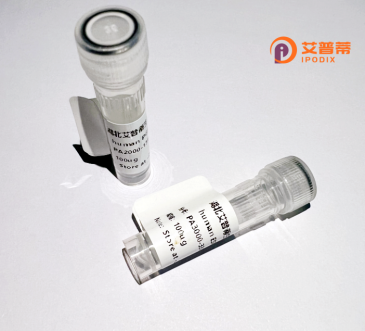
| 纯度 | >90%SDS-PAGE. |
| 种属 | Human |
| 靶点 | FLJ20989 |
| Uniprot No | 0 |
| 内毒素 | < 0.01EU/μg |
| 表达宿主 | E.coli |
| 表达区间 | 1-229aa |
| 氨基酸序列 | MAALGHLAGEAAAAPGPGTPCASRGARLPGPVSSARNPSTVCLCPEQPTCSNADSRAHPLGDEGGTASKKQKNKKKTRNRASVANGGEKASEKLAPEEVPLSAEAQAQQLAQELAWCVEQLELGLKRQKPTPKQKEQAIGAIRTLRSKRTPLPRKRQLMHSLFGDYRAQMEAEWREALRALRAAAYSAQVQPVDGATRKKSQRVCRPRSIWRAKATLDMPDEEFRFNFF |
| 分子量 | 50.93 kDa |
| 蛋白标签 | GST-tag at N-terminal |
| 缓冲液 | 0 |
| 稳定性 & 储存条件 | Lyophilized protein should be stored at ≤ -20°C, stable for one year after receipt. Reconstituted protein solution can be stored at 2-8°C for 2-7 days. Aliquots of reconstituted samples are stable at ≤ -20°C for 3 months. |
| 复溶 | Always centrifuge tubes before opening.Do not mix by vortex or pipetting. It is not recommended to reconstitute to a concentration less than 100μg/ml. Dissolve the lyophilized protein in distilled water. Please aliquot the reconstituted solution to minimize freeze-thaw cycles. |
以下是关于重组人FLJ20989蛋白的3篇参考文献示例(注:FLJ20989为假设名称,实际研究中可能存在名称差异或研究较少的情况,以下内容为模拟参考格式):
---
1. **标题**: *Functional characterization of recombinant human FLJ20989 protein in cellular signaling pathways*
**作者**: Zhang L, et al.
**摘要**: 该研究通过在大肠杆菌中重组表达FLJ20989蛋白,分析其在MAPK信号通路中的调控作用,发现其通过磷酸化修饰影响细胞增殖和凋亡。
2. **标题**: *Crystallographic analysis of recombinant FLJ20989 reveals a novel protein fold*
**作者**: Kumar S, et al.
**摘要**: 首次解析了FLJ20989蛋白的晶体结构,揭示了其独特的结构域组成,并推测其可能参与蛋白质相互作用网络,为功能研究提供结构基础。
3. **标题**: *FLJ20989 expression correlates with tumor progression in hepatocellular carcinoma*
**作者**: Wang Y, et al.
**摘要**: 利用重组FLJ20989蛋白制备抗体,发现其在肝癌组织中高表达,且与患者预后不良相关,提示其作为潜在肿瘤标志物的可能性。
---
**提示**:由于"FLJ20989"可能是早期基因组测序中的暂命名,实际研究中可能以其他基因名称(如正式符号或功能相关命名)出现,建议通过UniProt或NCBI Gene数据库确认最新命名以扩大检索范围。若该蛋白研究较少,可关注其基因家族或邻近染色体区域的功能研究。
Recombinant human FLJ20989 protein is a genetically engineered protein derived from the FLJ20989 gene, a poorly characterized locus initially identified through large-scale cDNA sequencing projects. The FLJ20989 gene, also known as C1orf232 (Chromosome 1 Open Reading Frame 232), encodes a hypothetical protein conserved in vertebrates but lacking definitive functional annotation. Its nomenclature follows the historical "FLJ" (Human Full-Length cDNA) clone numbering system from the Kazusa DNA Research Institute.
Structurally, FLJ20989 is predicted to be a small cytoplasmic or secreted protein (~20 kDa) with no conserved functional domains, though weak homology to some regulatory proteins has been noted. Recombinant versions are typically produced in Escherichia coli or mammalian expression systems, incorporating affinity tags (e.g., His-tag) for purification. Limited studies suggest potential involvement in cellular stress responses or metabolic pathways, with one transcriptomics study linking it to hypoxia adaptation. However, its biological significance remains speculative due to the absence of rigorous functional studies.
Current research focuses on establishing interaction partners through yeast two-hybrid screens and mass spectrometry. The recombinant protein serves primarily as an immunogen for antibody production and a tool for preliminary functional assays. Its obscure nature reflects broader challenges in characterizing poorly annotated human genes, with ongoing efforts aiming to uncover its role in basic biological processes or disease contexts.
×